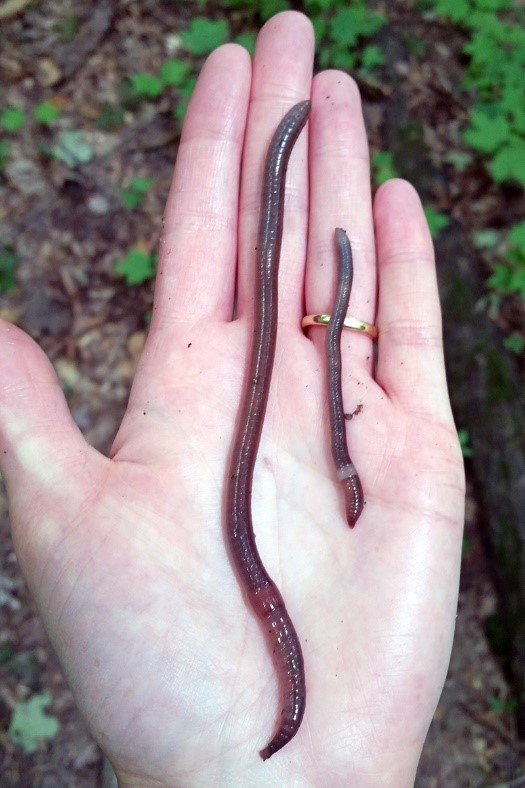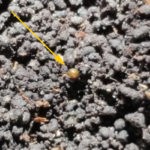It looks like spring has finally arrived! With the warmer temperatures, many people are probably anxious to be in their yards and gardens. With this comes the many plant sales and exchanges that commonly occur. However, this year everyone should be aware of a relatively new invasive species to the county, “jumping worms.” Unlike other pests that might be hiding in the daylily your neighbor dug from their garden and donated to the neighborhood sale, jumping worms have the ability to infest soil at high densities. They are known for changing the soil to resemble coffee grounds, creating a poor structure for plants to grow in. They also damage roots of plants and feed on the organic matter that plants, fungi and bacteria need for nutrients, removing much of it from the soil ecosystem. So, you may be asking how to get rid of them.

Adult Amynthas agrestis (left) and Amynthas tokioensis (right). (Photo: Marie Johnston, UW–Madison Department of Soil Science and Arboretum)
Unfortunately, there are no known ways to eliminate them.
The jumping worm is native to Asia and relatively little is known about them compared to the European earthworms that have been present since European settlement. It is known and sold under a variety of common names including crazy worms, Alabama jumpers and snake worms. This invasive pest has earned the common name due to their behavior when handled. They have rapid side-to-side motion, thrash, may jump into the air or shed their tails.
The worms are parthenogenetic, producing eggs without the need for a mate, so just one worm can start a new population. Jumping worms resemble regular earthworms (which are also not native here), but there are some important differences. They are more gray or brown in color than pink like other earthworms. They can be 1.5 to 8 inches long. Their clitellum, the band of lighter-colored tissue near the head is smooth, not raised like other earthworms and whitish, not pink. And their body is more rigid and does not produce slime like many other earthworms.
The jumping worms have an annual life cycle. In other words, they hatch from cocoons in the spring, grow rapidly and exist as mature adults from early summer to fall, and die during the winter, after laying plenty of cocoons. The cocoons are much more tolerant of temperature and moisture extremes than the worms and hatch the following spring.
Since the adults die in the winter and it is hard to detect the worms that hatch from cocoons in the spring, they can be unknowingly spread through plant exchanges and other landscape materials. Adult jumping worms usually are not seen until late June. Each worm has a life cycle of 60 days, so we can have two generations easily each year.
Controlling jumping worms is difficult for many reasons, but research has shown the benefit of several best management practices (BMPs) for reducing the spread of jumping worms. • Educate yourself, and others to recognize jumping worms
• watch for jumping worms and signs of their presence
• ARRIVE CLEAN, LEAVE CLEAN – Clean soil and debris from vehicles, equipment and personal gear before moving to and from a work or recreational area
• only use, sell, plant, purchase or trade landscape and gardening materials and plants that appear to be free of jumping worms and

Amynthas cocoon (at arrow) surrounded by earthworm casts. (Photo: Marie Johnston)
• only sell, purchase or trade compost that was heated to appropriate temperatures and duration following protocols that reduce pathogens.
Property owners who suspect they have jumping worms should keep any potentially invaded plant, soil, and mulch on their site. These materials should not be shared with anyone or transplanted on other properties. Sightings of jumping worms should be reported to the Wisconsin DNR by emailing invasive.species@wi.gov or uploading a photo to the First Detector’s Network, https://fyi.extension.wisc.edu/wifdn/get-involved/report-invasive-species/.
Remember they are a RESTRICTED species under Wisconsin’s Invasive Species Rule NR 40. This means that it is illegal to buy, sell, bring into the state, or release jumping worms to water or land in Wisconsin.
For more information on jumping worms:
https://hort.extension.wisc.edu/jumping-worms/
https://dnr.wi.gov/topic/Invasives/fact/jumpingworm/index.html



